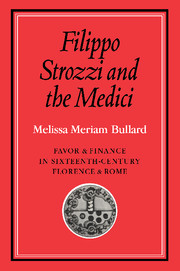1 - Introduction
Published online by Cambridge University Press: 07 October 2011
Summary
An army of ragged exiles defeated at Montemurlo in 1537 by Duke Cosimo de'Medici of Florence and a suicide note echoing the words of Cato found beside his body in the duke's prison a year later are the images most closely associated with the memory of Filippo Strozzi the Younger. When not confused from the outset with his father who was also named Filippo, builder of the magnificent family palace in Florence, Filippo the Younger is most often remembered as a tragic hero, defender of the lost Florentine Republic against her new masters the Medici dukes. But for most of his adult life Strozzi could hardly be called a champion of Florentine liberties against Medici hegemony. If anything he was one of the staunchest supporters of the Medici both in Florence and at the papal court in Rome, personally profiting from his association with them and the favor they bestowed. He unhesitatingly abetted Lorenzo di Piero de'Medici's machinations to make himself sole ruler of Florence and obligingly diverted the commune's money into the pope's war chest. Basking in the sun of Medici favor, he enjoyed a reputation for power, wealth, education and magnanimity befitting the brilliance of his age. As a merchant-banker and speculator he amassed a fortune of legendary size and built an international financial empire rivaling that of the famous Fugger of Augsburg.
- Type
- Chapter
- Information
- Filippo Strozzi and the MediciFavor and Finance in Sixteenth-Century Florence and Rome, pp. 1 - 8Publisher: Cambridge University PressPrint publication year: 1980



